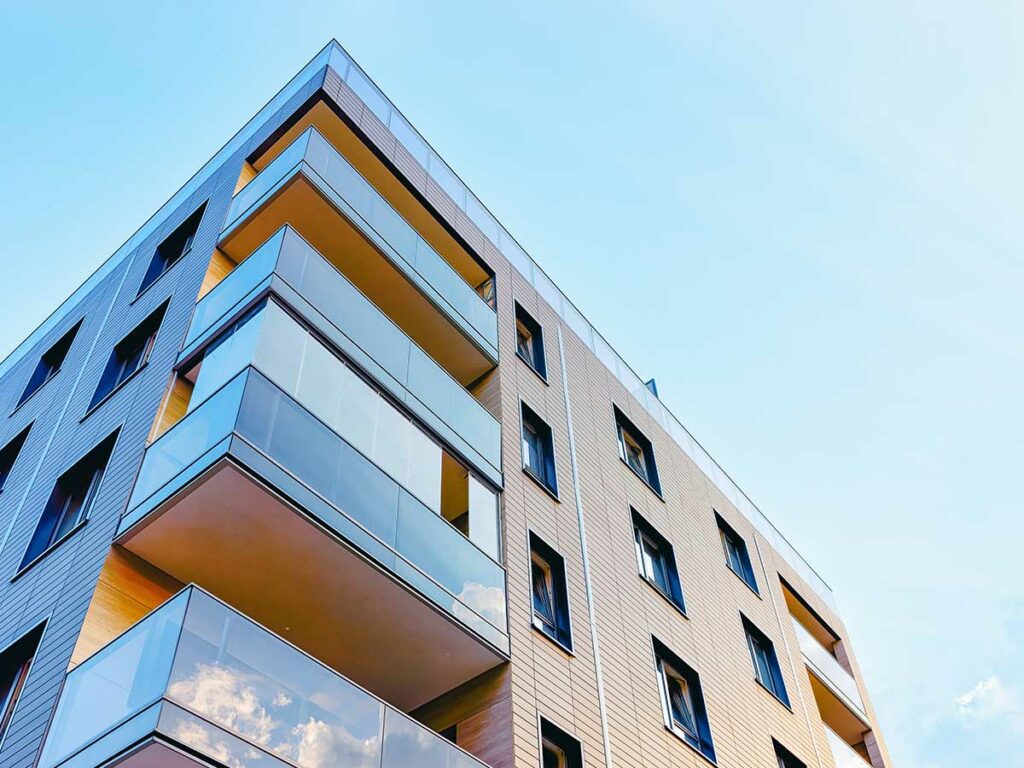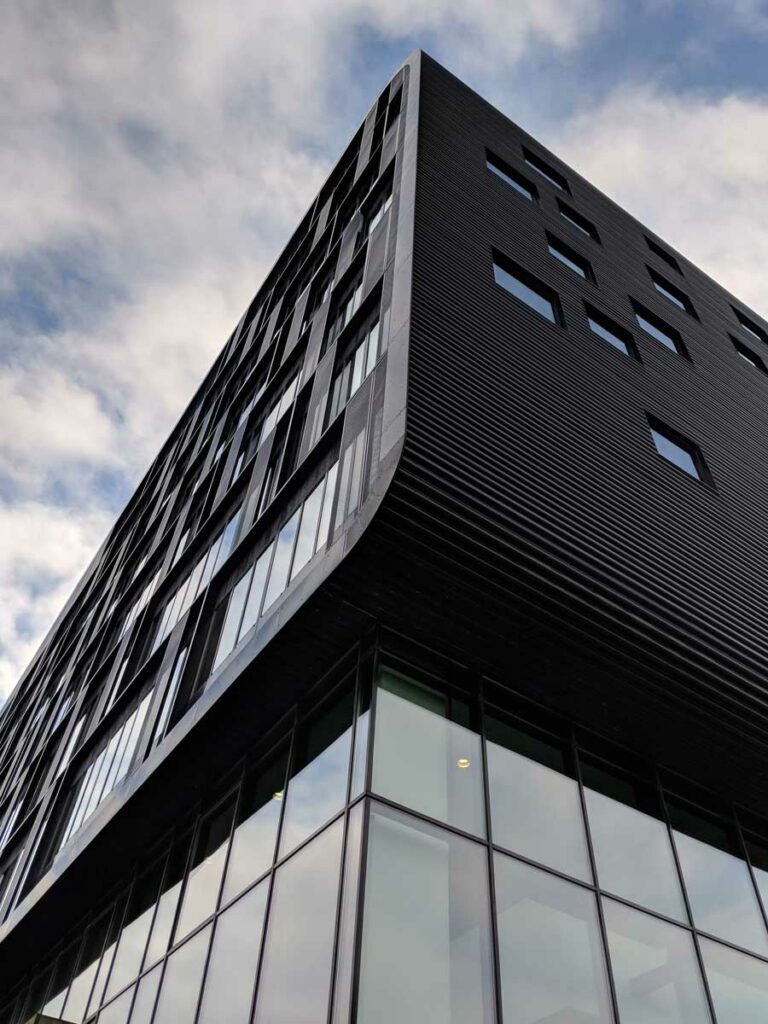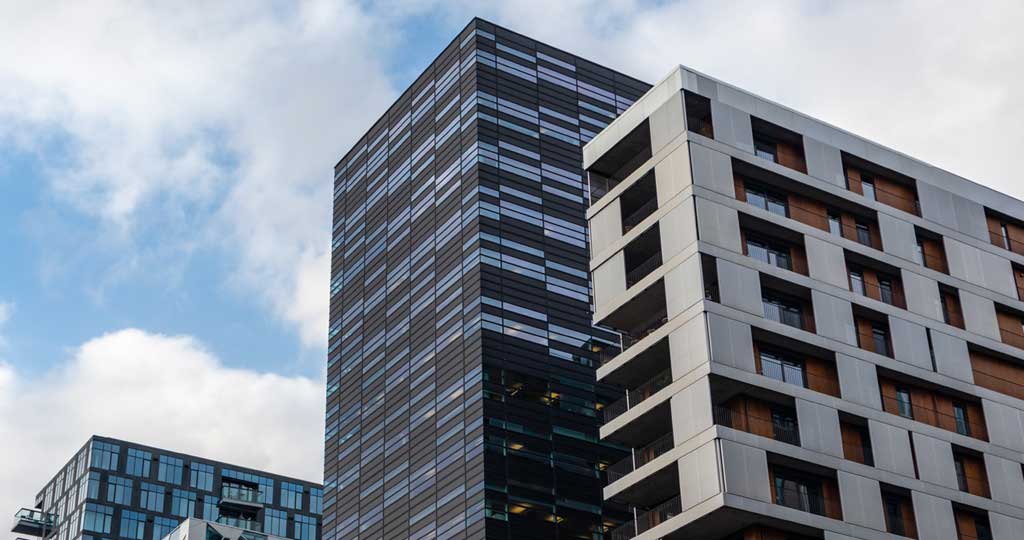Every year an estimated 5,000 people die in residential fires across Europe, while about ten times that number are injured1. Since the tragic Grenfell Tower fire in London in 2017, the spotlight has fallen on fire safety in high rise buildings.
Fire safety in high rise & high risk buildings
Fires can be more dangerous in high rise residential buildings than in low rise homes. Why is this?
- During a fire it is more difficult to evacuate occupants from tall buildings.
- Fire and smoke tend to spread vertically.
- It more challenging for fire services to fight fires in tall buildings.
- Finally, if the external cladding of a high rise building features combustible materials, as was the case at Grenfell, it can cause a fire to spread quickly up its external surface. This is why it is important to specify non-combustible materials in high-rise facades.

The Grenfell fire led to a review of the building regulations, chaired by Dame Judith Hackitt. Her review described the regulatory system for high rise buildings as “not fit for purpose”, and led to an initial ban on combustible materials in the external walls of high-rise residential buildings over 18 metres high in England, Wales and Northern Ireland, and 11 metres in Scotland, along with other changes. This has now been reduced to 11 metres across the board, though these details are still subject to change.
What are high risk buildings for fire?
Approximately 80 per cent of deaths from fire occur in homes, according to the European Fire Safety Alliance. Tall residential buildings are regarded as a particular risk because of the potential for large numbers of fatalities.
This doesn’t just apply to conventional homes and apartments, but also to other types of building where people sleep, such as:
- boarding schools
- prisons
- hotels and hostels
- residential colleges etc.
Certain types of residential building, such as hospitals and care homes, are particularly vulnerable, because occupants may be unable to escape quickly. Many of these building types also have a high density of occupants, which is an extra risk factor.
Considering fire safety at design stage & fire safety engineering
Planning for fire safety from the earliest stages of design is critical for delivering a fire safe building.
There are multiple ways that proper design can reduce the risk of fire , including:
- Designing out ignition sources
- Limiting the amount of material that will burn in the event of a fire
- Designing the building so that residents can escape safely in the event of a fire
- Designing the building so that heat and smoke can be contained
- Designing the building the so that it resists fire and maintains its structural integrity
The RIBA Plan of Work recommends considering whether specialist fire expertise is needed at the outset of your project. It says that a fire safety strategy should be integrated as soon as the building project is identified, and should continue right through to the post-occupancy management of the building, providing a “golden thread” of fire safety information throughout the building’s lifetime.
What is the difference between ‘reaction to fire’ and ‘fire resistance’?
When it comes to the fire safety of construction materials, two terms you frequently hear are ‘fire rated’ and ‘fire resistant’. But these terms are often confused.
The Euroclass system (EN 13501-1) measures ‘reaction to fire’ and assigns fire ratings for building materials on a scale from A1 to F. These ratings or classifications measure the extent to which a product will ignite and contribute to a fire. An A1 rated material is regarded as non-combustible. It will not cause a fire to spread, but this does not mean it will resist fire either.
Fire resistance testing, on the other hand, assesses the performance of construction elements for their load-bearing or fire separating properties – usually termed their fire resistance – for their regulated use in buildings. It is measured in the number of minutes of resistance the material can provide.
Read on to find out more about reaction to fire and fire resistance.
Euroclass ratings for external wall membranes in high-rise buildings
What does the ban on combustible materials in the external walls of high rise buildings mean in practice?
When specifying materials which become part of an external wall on buildings with a storey at least 11 metres above ground level we must consider if they need to achieve class A2-s1,d0 or above. Depending on the project location and building purpose different building regulations apply.
Membranes are one of the components in external walls that are exempt from meeting class A2-s1,d0. They are required to meet classification B-s3,d0. Whilst this is the requirement, we recommend when designing buildings that require a breather membrane, products that meet classification A2-s1,d0 should be considered from the outset. Breathable membranes such as Partel’s EXOPERM DURO A1 or EXOPERM MONO DURO A2 could be specified.
Decoding the fire performance of building materials & membranes
Post-Grenfell, the primary means of evaluating the reaction to fire of construction products in the UK is the European Standard EN 13501 – ‘Fire Classification of Construction Products and Building Elements’. This represents a move away from the old British system BS 476.
The Euroclass system – what do the classifications mean?
EN 13501-1 outlines a series of fire tests and, depending on the results, a building product may achieve a reaction to fire classification on a scale from A1 to F. The standard provides additional classifications for the production of smoke and flaming droplets. A classification might be given as ‘A2-s3,d1’. But what does this mean?
The primary classifications are as follows:
| A1 | Non-combustible material |
| A2 | Limited combustibility (England, Wales & NI); Non-combustible (Scotland) |
| B | Combustible material – Very limited contribution to fire |
| C | Combustible material – Limited contribution to fire |
| D | Combustible material – Medium contribution to fire |
| E | Combustible material – High contribution to fire |
| F | Combustible material – Easily flammable |
What do the s and d classifications mean?
Products are also given classifications for the production of smoke and flaming droplets. Flaming droplets result in burns and cause fires to spread. Smoke inhalation, meanwhile, is the leading cause of fatalities from fire.
Production of flaming droplets is classified as follows:
D0 = No droplets
D1 = Some droplets
D2 = Quite a lot of droplets
Smoke production is classified as follows:
S1 = Little or no smoke
S2 = Quite a lot of smoke
S3 = Substantial / heavy smoke
What is fire resistance?
Fire resistance measures the ability of a construction element to maintain its load bearing function (ie structural capacity), integrity (the ability to prevent flames and gases from passing through) and insulation function (the ability to prevent heat from passing through). These are denoted by the letters R, E and I respectively.
Fire resistance is measured in number of minutes. Sometimes figures are quoted separately, for example an R of 30 minutes and an E of 60 minutes, while sometimes an assembly may be quoted as having an REI of 100 minutes, which means the assembly provides all three functions for 60 minutes. Minimum periods of fire resistance for elements in different building types are given in the building regulations. Fire resistance is covered by EN13501-2, EN1366 and other related standards.
Standardised fire tests explained
EN-13501-1 outlines a range of tests to determine the fire classification of a product.
Ignitability test (EN ISO 11925-2) — E or F rating
The product is placed in a chamber and exposed to a gas flame. Depending on the time it takes to ignite and the speed with which the flame spreads, it may achieve an E or an F rating. If the product achieves a 30 second exposure, it may be eligible for a higher rating.
Single burning Item test (EN 13823) — B, C or D rating
A product may achieve a B, C or D rating depending on its performance in this test. The product is exposed to a small fire in a full size test room. The release of heat and smoke are measured, as are the production of droplets and spread of flames.
Gross heat of combustion test (EN ISO 1716) — A1 or A2 rating
This test is for products seeking an A1 or A2 rating. The material is ground to powder and set alight in an oxygen-filled container that is surrounded by water. Testers measure the change in the water temperature and based on this a calculation is performed to work out the gross heat of combustion, also known as calorific value. This is the total heat energy released when the material undergoes complete combustion in oxygen.
Non-combustibility test (EN ISO 1182) – A1 or A2 rating
This test is also for products seeking an A1 or A2 rating. The product is placed into a furnace at about 750 C, and temperature changes in the material are observed using sensors. The sample is observed for flaming, and the mass of the material is measured before and after.
Partel membranes for use in high rise buildings
Partel offers a variety of fire-rated membranes for use in high rise buildings, and recently launched two new fire-rated breather membranes, EXOPERM DURO A1 and EXOPERM MONO DURO A2.
Below is our list of high-rise suitable membranes and their ratings.
Breather membranes
- EXOPERM DURO A1
- EXOPERM MONO DURO A2 – A2-s1,d0
- EXOPERM MONO DURO 200 — B-s1,d0
- EXOPERM MONO SA 250 – B-S1,d0 (when affixed to a non-combustible material, otherwise Class E applies)
Vapour control layers
- IZOPERM PLUS A2 – A2-s1,d0

All of these Partel membranes meet UK regulations for high rise buildings. They also all achieve the highest possible classifications for production of smoke and flaming droplets, critical considerations for fire safety.
Of course, it is important to consider other performance factors when specifying a membrane, such as:
- breathability
- air permeability
- UV resistance,
- how the membrane is suited to your construction type
Best practice is to specify the membrane with the highest fire classification once all other key performance factors have been met.
Fire safety: a crucial parameter of building sustainability
The twin goals of fire safety and sustainability can sometimes appear to be in conflict. For example, the UK’s ban on combustible materials also restricted the use of timber — a lower carbon material than concrete or steel — in mid and high rise buildings. But ultimately, fire safety is a core principle of building sustainability. Why?
- Fires shorten the lifespan of a building. A serious fire can require substantial parts of a building, or an entire building, to be rebuilt — generating all of the carbon emissions and pollution associated with the new construction.
- Fires emit large amounts of carbon dioxide and other toxic gases into the air and nearby water bodies. One study found that warehouse fires in England release an estimated 135,000 tonnes of CO2 each year.2
- Firefighting foams can pollute nearby water bodies
- Demolition of fire-damaged buildings creates huge quantities of waste, some of which may be toxic.
“Fire resilience is currently the missing part of the sustainable buildings puzzle – a building is not truly sustainable if it can burn to the ground,” says Fire Safe Europe.
Fire safety in the retrofit drive
There is currently a major drive to retrofit buildings across Europe. The EU’s Renovation Wave aims to renovate up to 35 million buildings by 2030. Meanwhile, the UK government wants all homes to achieve an Energy Performance Certificate (EPC) of C by 2035.
The retrofit drive offers an opportunity to improve the fire safety of buildings, but there is also the risk of making buildings less fire safe if combustible assemblies are installed.
Buildings which are the least efficient and most likely to experience fuel poverty — such as older social housing blocks — are often those most at risk from fire too. So, if done right, the retrofit drive presents a unique opportunity to improve energy efficiency, comfort and fire safety all at once.
References:
- https://www.europeanfiresafetyalliance.org/our-focus/statistics
- https://www.business-sprinkler-alliance.org/downloads/details/the-financial-and-economic-impact-of-warehouse-fires-cebr





